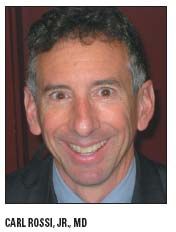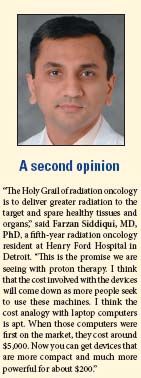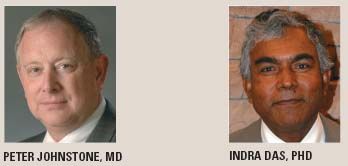Proton-beam Rx reduces prostate cancer recurrence
Prostate cancer patients administered high doses of proton-beam therapy appear to have a markedly reduced risk of disease recurrence when compared with other low-risk patients treated with conventional radiation therapy, according to two recent studies.
Prostate cancer patients administered high doses of proton-beam therapy appear to have a markedly reduced risk of disease recurrence when compared with other low-risk patients treated with conventional radiation therapy, according to two recent studies.
“At 10 years after treatment, 93% of low-risk patients treated with high-dose radiation were free of prostate cancer, compared with 69% of patients who had conventional doses,” said Carl Rossi, Jr., MD, lead author of one study. That difference reached statistical significance (P < .0001), added Dr. Rossi, who is an associate professor of radiation medicine at Loma Linda University in Loma Linda, Calif.
In a second study, which specifically scrutinized outcomes to measure adverse events with use of the proton boost regimen, researchers again found that the treatment proved safe.

“There was minimal early genitourinary [GU] and gastrointestinal [GI] toxicity in the prospective trial with proton therapy,” said principal investigator Nancy Mendenhall, MD, professor and chair of radiation oncology at the University of Florida in Gainesville and Jacksonville.
No trade-off between dose and quality of life
“This first of its kind study provides evidence of the benefits of giving high radiation doses to low- and intermediate-risk prostate cancer patients,” Dr. Rossi said. “Delivering higher doses with proton-beam therapy is safe, effective, and has minimal side effects.”
In addition, Dr. Rossi said there were no significant differences between the groups in changes in urinary or bowel functions, indicating that the higher-dose treatment did not come with a cost in quality-of-life issues.
The researchers enrolled patients with stage T1b or T2b prostate cancer and a prostate specific antigen (PSA) level of 15 ng/mL or less. These patients were randomized to receive a boost to the prostate alone using conformal protons of either 19.8 or 28.8 Gy equivalent (Gye). All patients then received 50.4 Gy at 1.8 Gy per fraction using three-dimensional conformal photons to the prostate, seminal vesicles, and periprostatic tissues. No patient received androgen suppression with their radiation therapy (ASTRO 2009 abstract 22).
Of the 393 eligible patients, 197 received the conventional dose of 70.2 Gye and 196 received a high dose of 79.2 Gye. The median follow up was 8.9 years.

Dr. Rossi said men in the high-dose arm were less likely to have local failure than those in the conventional arm. His group observed a 43% reduction in the risk of local failure (P = .0001). He said the biochemical failure, expressed by a rising PSA level, was experienced by 35.3% of the patients who received the conventional treatment compared with 16.3% of the men who were randomized to the high-dose arm (P = .0001).
Among the men who had low-risk cancer, the 10-year biochemical failure rate was 29% in the conventional-dose arm and 6.1% in the high-dose arm (P = .0001), Dr. Rossi said. There was a trend in the same direction for the smaller group of intermediate-risk patients. Of those men, the biochemical failure rate was 44.6% among those who received the conventional radiation dose compared with 28.6% of those who were assigned to the high-dose group (P = .06).

In addition, Dr. Rossi said 11% of the men who received conventional dosing subsequently required androgen deprivation for recurrence compared with 6% of the men who had been assigned to high-dose radiation (P = .047).
Overall survival was not statistically different between the groups: 83.4% of patients in the high-dose group remained alive compared with 78.4% of those who received conventional treatments.
Minimal toxicity
In the second study on adverse events, Dr. Mendenhall reported that fewer than 1% of patients had grade 3 adverse effects, and those patients appeared to have pretreatment urinary problems.
The prostate cancer patients included 212 men who underwent procedures between August 2006 and October 2007. All patients had a minimum, potential one-year follow up. Dr. Mendenhall said that 46 men reported grade 2 toxicities and one reported grade 3 toxicity at six months; at 12 months, 48 grade 2 toxicities were reported along with one grade 3 toxicity (ASTRO 2009 abstract 23).
Cost remains a barrier to setting up proton-beam therapy sites. Dr. Mendenhall said that the facility in Jacksonville, which includes a complete suite with conventional as well as proton-based devices, costs $110 million in 2006. However, she said that as the use of proton-beam therapy expands, the costs are expected to come down.
Vantage Point
Dose escalation with minimal toxicity can be achieved
Proton-beam therapy for prostate cancer has been used by some as an example of therapy that results in a cost increase, but without a corresponding increase in favorable outcomes or effectiveness, said Dr. Johnstone and Dr. Das. The presentations by Dr. Rossi and Dr. Mendenhall contribute critical data that can lead to more informed decision-making about the role of protons in prostate radiotherapy, they said.
Dr. Johnstone is the chair of the department of radiation oncology at the Indianapolis-based Indiana University (IU) School of Medicine. Dr. Das is the department vice chair. Both are responsible for the medical and technical components of care at the Bloomington-based Midwest Proton Radiotherapy Institute, an affiliate of the IU Simon Cancer Center and a Clarian Health partner.

The groups at Massachusetts General Hospital in Boston, Loma Linda, and Florida have taken the global lead in providing much-needed data on efficacy of proton beams. However, these two abstracts tell us more about radiation therapy dose escalation than about proton effectiveness, they said.
“Dr. Mendenhall's data revealing a low frequency of acute side effects in 212 prostate cancer patients are critical to the debate. Her group provided data on early GU and GI toxicities with escalating radiation doses. Grade 3 GU and GI toxicity were each < 1% with a minimum one-year follow up. While Dr. Mendenhall and her group have corroborated previous findings that it is possible to increase the dose without undue toxicity, it should be noted that the follow up is limited and such toxicity may increase over time,” they stated.
Dr. Rossi confirmed prior data by his group: Increasing the total radiation dose from 70.2 Gye to 79.2 Gye showed decreased risk of recurrence for prostate cancer patients without increasing GU and GI toxicities. However, these findings cannot be interpreted as being specifically due to protons, since protons were only used for the boost portion of treatments, Dr. Johnstone and Dr. Das said.
As noted by these studies and previous research, dose escalation is achievable-with conventional photons or with protons-with minimal toxicity. “We await final results of RTOG 0126 trial, which is evaluating this question in prospective, randomized fashion nationwide,” they said. “Protons, with their unique physical characteristics, may reduce GU and GI toxicities that occur at higher radiation dosage.”